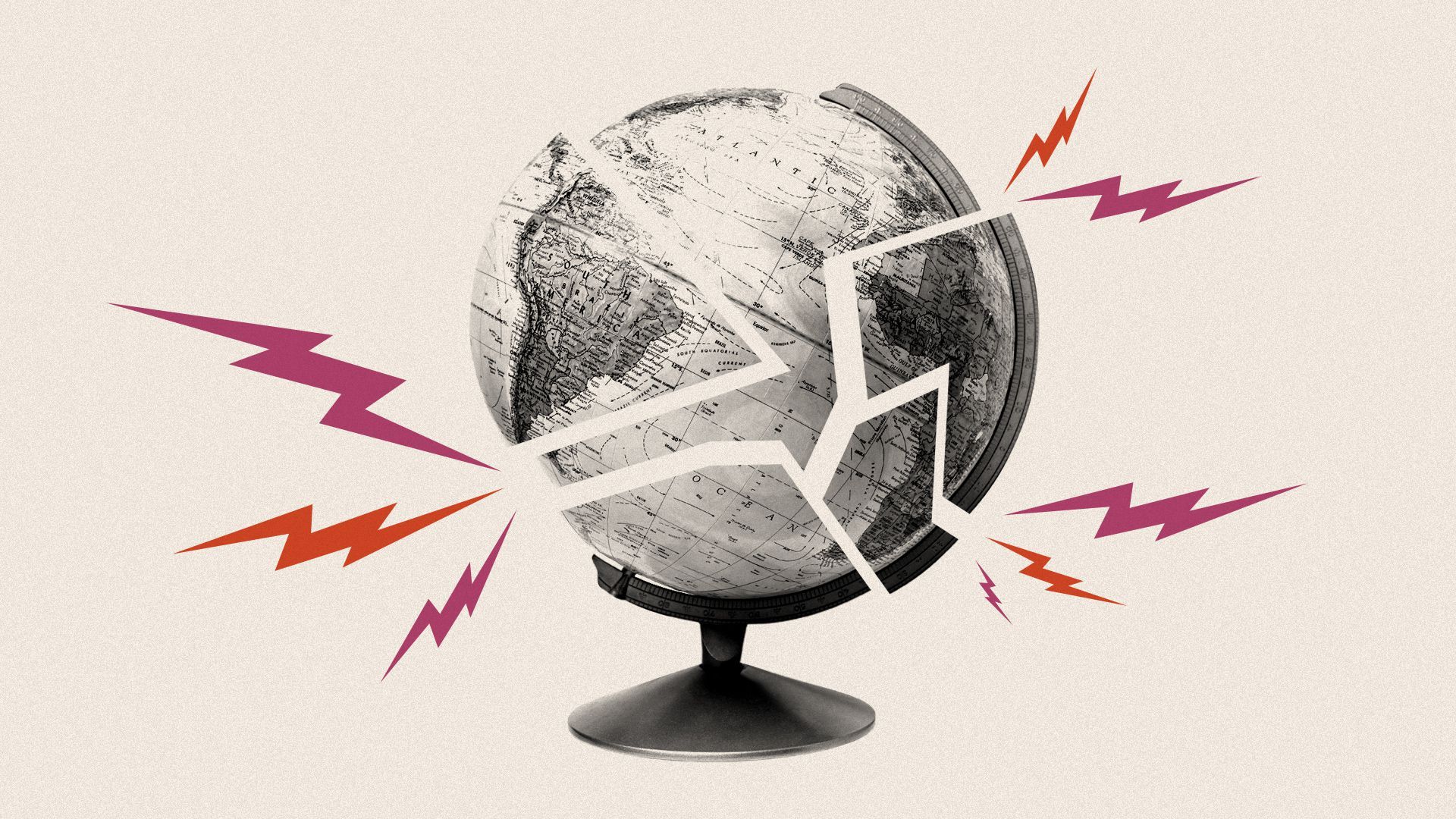Illustration: Aïda Amer/Axios
All the tough talk and finger-pointing between officials in the U.S. and China about this pandemic belies cooperation among scientists in the two countries who are racing to understand the deadly virus.
Why it matters: Pandemics are a global problem that scientists say require a global solution. But scientific advances are increasingly seen as a national competitive advantage, creating tension that some experts warn could undercut global efforts to defeat COVID-19.
What's happening: Scientists in the U.S. and China are working together on testing COVID-19 treatments and drug candidates, developing vaccines, and understanding the origin and spread of SARS-CoV-2, the virus that causes COVID-19.
- A new analysis for Axios by Pedro Parraguez of Dataverz, a data analytics startup in Copenhagen, found about 407 papers published so far this year are co-authored by researchers at institutions in the U.S. and China, out of roughly 7,770 published by researchers in the two countries. The analysis was run using the Dimensions.ai dataset and included mostly pre-print papers for this year.
- The U.S. Centers for Disease Control and Prevention and the University of Hong Kong are the top bridges between institutions working on coronaviruses in the U.S. and China, based on another analysis by Parraguez, using co-authorship of papers as a metric for collaboration. The Chinese Academy of Sciences, China's CDC, the U.S. National Institutes of Health and the University of North Carolina at Chapel Hill feed those efforts and are important local and regional bridges.
- "There have been huge amounts of collaboration because of the bridges that were built, 10, 15, 20 years ago," says virologist Richard Kuhn of Purdue University, citing students from China studying in the U.S. and collaboration between scientists on past outbreaks.
The big picture: There are stark warnings of "vaccine nationalism" because if a COVID-19 vaccine becomes available, there won't be enough at first to immunize the global population.
- The World Health Organization last week launched Access to COVID-19 Tools (ACT) Accelerator, an agreement of governments, companies and other organizations to collaborate on COVID-19 diagnostic testing, treatments and vaccines with an emphasis on making sure "no one is left behind."
- Political leaders from the U.S. and China did not participate in the launch but there is a rolling campaign to join.
The bigger picture: Atoms, bits and base pairs fuel the Great Powers race. The U.S. is trying to keep its top spot as China tries to establish scientific prowess.
- The next 5G, artificial general intelligence, quantum computing and now a vaccine for COVID-19 are seen by leaders as strategies for national security.
Yes, but: The country's scientific enterprises are intertwined.
- The U.S. collaborated most frequently with authors from China — about 26% of U.S. internationally co-authored articles in 2018, according to a report earlier this year from the National Science Board.
The U.S. and China both benefit from their collaboration, says Jenny Lee of the University of Arizona.
- China brings financial investment and the U.S., with its established scientific heft, extends the global reach of China's research, says Lee, who studies global higher education.
- At the same time, there are long-running concerns about IP theft and foreign influence in U.S. research, and some U.S. lawmakers have proposed limiting the areas of science that Chinese students can study.
The two countries worked together during the SARS outbreak in 2003, the Ebola outbreak in West Africa in 2014 and other epidemics over the past 20 years.
- The U.S. Centers for Disease Control and Prevention says it offered to help its parallel institution in China when the COVID-19 outbreak began but, the FT reports, the CDC hasn't asked them to collaborate formally on research.
- China's initial communication of the emerging epidemic, which included delays and inaccuracies, led to criticisms and concerns about how much the U.S. and the rest of the world could trust Beijing.
For some, those concerns are even more reason to collaborate.
- "The more engagement we have, the more opportunities we have to build relationships and inform our understanding of this emerging infectious disease threat," says Margaret Hamburg, foreign secretary of the U.S. National Academy of Science and a former FDA commissioner.
- "There is a long tradition of science diplomacy," she says, pointing to the role of nuclear scientists in opening up the former Soviet Union and researchers in the U.S. and China working on biosecurity and biosafety today.
What to watch: "Nationalism and attacks can erode even good collaborations [among international colleagues]," says Kuhn, who is also the editor-in-chief of the journal Virology.
- "This can have a big impact on the advancement of science," he says.
- "Tensions between techno-nationalism and techno-globalism are unlikely to diminish in the future ... therefore, societies should not assume that international scientific collaborations will flow naturally, but rather should nurture them carefully — although urgently — through renewed diplomatic efforts, funding programs, and policy instruments," Rajneesh Narula and José Guimón wrote recently in Issues in Science and Technology.
The bottom line: Scientists are already multipolar, says Narula, a professor of international business regulation at the University of Reading in the U.K. "There can be three poles, which is what is happening: the U.S., Europe and China. Everyone is willing to accept that, except perhaps the poles themselves."
Go deeper:

No comments:
Post a Comment